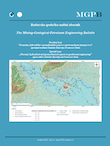Ground temperature monitoring for a coaxial geothermal heat exchangers field: practical aspects and main issues from the first year of measurements.
DOI:
https://doi.org/10.17794/rgn.2018.5.5Abstract
Ground temperature at shallow depth (< 50 m) is not stable, nor in space, neither in time, and its behaviour is the result of superimposition of effects of heat pulses of different origin: solar, geothermal and anthropic. The correct assessment of ground temperature is a crucial point when designing a shallow geothermal energy system. In geothermal closed loop projects, more the borehole heat exchangers are short, more the contribution of the ground temperature variability on the heat exchange is prominent. Monitoring ground temperature can be very useful to correctly understand the behaviour of a shallow geothermal reservoir subjected to heat extraction and/or injection by a ground source heat pump system. The present work illustrates the practical aspects and main issues occurred in the installation, testing and working phases of a monitoring system realised to record ground temperature in a geothermal application. The case study is a field of eight coaxial borehole heat exchangers, 30 m long, connected to a novel prototype of dual source (air and ground) heat pump.
Downloads
Published
How to Cite
Issue
Section
License
Copyright (c) 2018 authors and journal

This work is licensed under a Creative Commons Attribution 4.0 International License.
Creative Commons-BY
Authors who publish with this journal agree to the following terms:
In agreeing this form, you certify that:
- You read the ethical codex of the RGN zbornik available at journal web.
- You submitted work is your original work, and has not previously been published and does not include any form of plagiarism.
- You own copyright in the submitted work, and are therefore permitted to assign the licence to publish to RGN zbornik.
- Your submitted work contains no violation of any existing copyright or other third party right or any material of an obscene, libellous or otherwise unlawful nature.
- You have obtained permission for and acknowledged the source of any illustrations, diagrams or other material included in the work of which you are not the copyright owner.
- You have taken due care to ensure the accuracy of the work, and that, to the best of your knowledge, there are no false statements made within it.
- All co-authors of this submitted work are aware of, and in agreement with, the terms of this licence and that the submitted manuscript has been approved by these authors.
Publication licence
You retain copyright in your submitted work, according to journal license policy (CC-BY). By signing this form you agree that RGN zbornik may publish it under the publication licence. In summary the licence allows the following:
Anyone is free:
- To copy, distribute, display, and perform the work.
- To make derivative works.
Under the following conditions:
- The original author must always be given credit.
- The work may not be used for commercial purposes.
- If the work is altered, transformed, or built upon, the resulting work may only be distributed under a licence identical to this one.
Exceptions to the licence
In addition to publishing the work printed under the above licence, RGN zbornik will also enable the work to be visible online.
The journal editorial can change the licence rules anytime but it cannot retroactively restrict author(s) rights.


